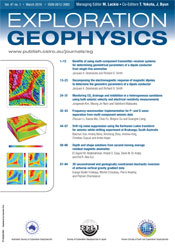
Exploration Geophysics
Volume 47 Number 1 2016
EG14076Benefits of using multi-component transmitter–receiver systems for determining geometrical parameters of a dipole conductor from single-line anomalies
We show the advantages of using multi-component transmitter–receiver systems for determining the geometry of a dipole conductor. We find that single transmitter systems are unable to resolve the orientation of an axially symmetric conductor and subsequently determine which measurements from a multi-component transmitter–receiver system are critical to address this problem.
EG14070Decomposing the electromagnetic response of magnetic dipoles to determine the geometric parameters of a dipole conductor
A novel automatic data interpretation algorithm is presented for modelling airborne electromagnetic (AEM) data acquired over resistive environments, using a single-component transmitter, where the position and orientation of a dipole conductor is allowed to vary in three dimensions. This algorithm is tested on both synthetic and field data.
EG15002Monitoring CO2 drainage and imbibition in a heterogeneous sandstone using both seismic velocity and electrical resistivity measurements
Seismic velocity and electrical resistivity were measured simultaneously to monitor the behaviour of carbon dioxide (CO2) during CO2 drainage and imbibition within a heterogeneous, clay-containing Tako sandstone sample. Employing Archie’s equation and the Gassmann fluid-substitution equation, electrical resistivities and P-wave velocities were analysed respectively and interpreted to evaluate CO2 saturation.
EG14047Frequency-wavenumber implementation for P- and S-wave separation from multi-component seismic data
This paper presents a modified separation equation of P- and S-waves for multi-component seismic data in the frequency-wavenumber domain. The equation can be applied to the seismic data which are recorded on the laterally heterogeneous free surface.
EG14086Drill-rig noise suppression using the Karhunen-Loéve transform for seismic-while-drilling experiment at Brukunga, South Australia
To overcome the challenge of surface wave interference generated from drill rigs for seismic-while-drilling, we compare two wavefield separation methods: (1) the Karhunen-Loéve (KL) transform and (2) the f – k filter. The results show that drill-rig noise can be effectively suppressed in the correlation domain.
EG14073Depth and shape solutions from second moving average residual magnetic anomalies
We have developed an efficient method to simultaneously determine the depth and shape of a buried structure from second moving average residual magnetic anomalies. The method is based on computing the standard deviation of the depths for each shape factor, and was applied to synthetic and field data.
EG140843D unconstrained and geologically constrained stochastic inversion of airborne vertical gravity gradient data
This article presents an inversion tool for airborne gravity gradient data that yields a 3D density model using stochastic methods i.e. cokriging and conditional simulation. This method uses geostatistical properties of the measured gravity gradient to estimate a 3D density model. Applications to modelled and survey data demonstrate the performance of the method.

